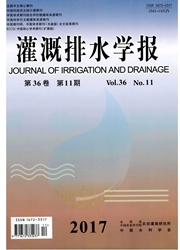

 中文摘要:
中文摘要:
为了探讨长期再生水灌溉氮素增效机制,以2011—2014年番茄收获后再生水和清水灌溉土壤为研究对象,测定了不同年份0-10、10-20、20-30、30-40、40-60cm土层的土壤脲酶和过氧化氢酶活性。结果表明,土壤脲酶活性随着再生水灌溉年限的增加而逐渐增强,且再生水灌溉根层土壤脲酶活性高于清水灌溉,表明再生水灌溉可促进土壤矿质氮素的形成和提高土壤供氮能力;再生水灌溉提高设施土壤过氧化氢酶活性,并且长期再生水灌溉后过氧化氢酶活性高于清水灌溉,表明再生水灌溉增强设施土壤的解毒能力、改善土壤的缓冲性能,提高作物对土壤逆境的适应能力。
 英文摘要:
英文摘要:
In order to explore the nitrogen synergistic mechanism of long-term reclaimed water irrigation,after tomato harvesting,soil urease and catalase activities of 0-10cm,10-20cm,20-30cm,30-40cm and 40-60cm soil layers were determined under reclaimed water(Re)irrigation and clean water irrigation(CK)from 2011 to 2014.The results showed that,along with the extension of reclaimed water irrigation years,soil urease activity increased,at the same time,the root layer soil urease activity under reclaimed water irrigation was higher than that under clean water irrigation,illustrating that reclaimed water irrigation promoted the formation of mineral nutrients and enhanced soil nitrogen supply capacity.Reclaimed water irrigation could improve the activity of soil catalase,and catalase activity under long-term reclaimed water irrigation was higher than that under clean water irrigation,indicating that reclaimed water irrigation strengthened the detoxification of soil,improved soil buffer performance and increased crop ability to adapt to the soil adversity.
 同期刊论文项目
同期刊论文项目
 同项目期刊论文
同项目期刊论文
 期刊信息
期刊信息
